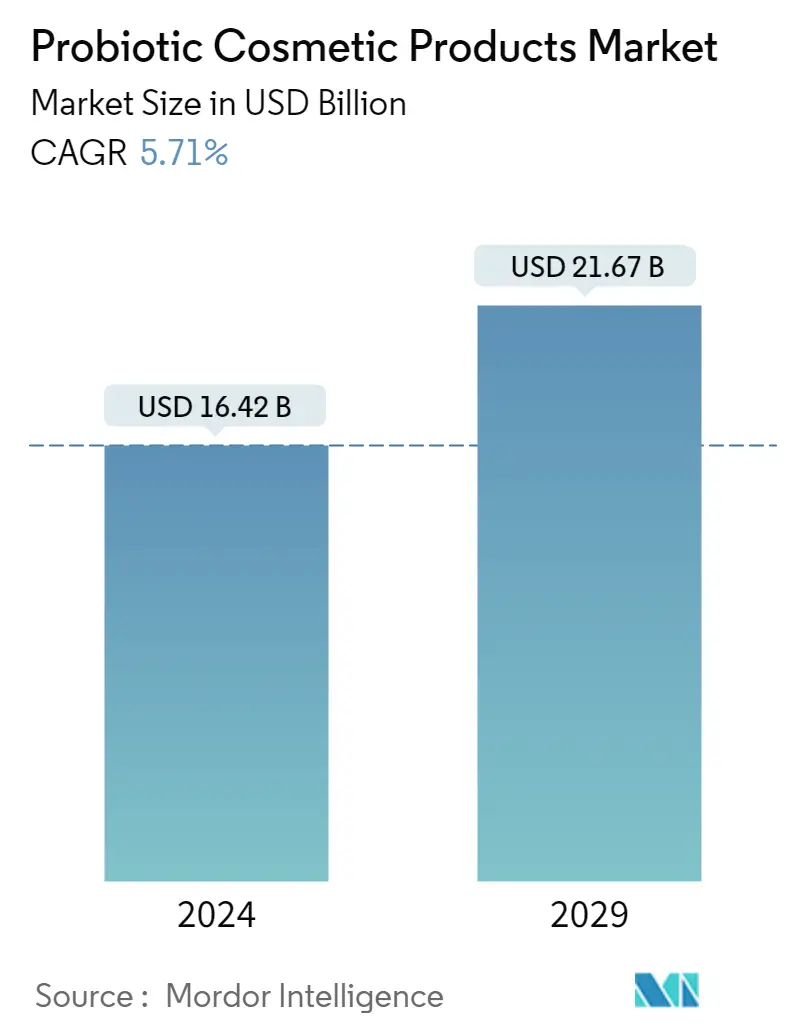Market Size of Probiotic Cosmetic Products Industry

| Study Period | 2019 - 2029 |
| Market Size (2024) | USD 16.42 Billion |
| Market Size (2029) | USD 21.67 Billion |
| CAGR (2024 - 2029) | 5.71 % |
| Fastest Growing Market | Asia Pacific |
| Largest Market | North America |
Major Players
*Disclaimer: Major Players sorted in no particular order |
Probiotic Cosmetic Products Market Analysis
The Probiotic Cosmetic Products Market size is estimated at USD 16.42 billion in 2024, and is expected to reach USD 21.67 billion by 2029, growing at a CAGR of 5.71% during the forecast period (2024-2029).
- The rise in popularity of probiotics as a main functional ingredient is significant because of their efficiency against various skin concerns, such as acne, wrinkle, and blemishes which are anticipated to drive market growth during the study period. Furthermore, a rise in demand for natural cosmetics among various consumer groups, particularly millennials, supported by growing awareness about their clinical evidence and efficacy, has also increased the market's growth.
- Owing to the growing demand for products with natural ingredients and due to a shift towards sustainable raw materials, manufacturers of conventional cosmetics and personal care products are also introducing products with more natural ingredients, like probiotics. Future product launches are predicted to shift as a result of this trend.
- Additionally, catering to the demand, new probiotic ingredients are being launched by manufacturers specifically to use in cosmetic products. For instance, in April 2022, Probi (Lund, Sweden), in collaboration with Symrise, created a new skincare ingredient, SymFerment, a moisturizing active ingredient that the company claims is based on a byproduct of Probi's probiotic that is produced by the fermentation of Lactiplantibacillus (Lactobacillus).
- Moreover, factors such as growth in personal appearance, skin, hair, health, and wellness coupled with demand for multi-functional beauty products, which allow consumers to extract maximum value by spending on a single development, are the key trends expected to drive the probiotic cosmetic products market in the coming years.
- Also, as people spend time on social media and many fashion and skincare influencers burst onto the scene, brands could proliferate their digital presence with partnerships and increase their brand equity through promotions. This, in turn, is increasing traffic to the company websites and allowing cosmetic brands to sell direct-to-consumer with minimal focus on logistics.
Probiotic Cosmetic Products Industry Segmentation
Probiotic cosmetic products are beauty products that contain specific strains of probiotic microbes that are beneficial for skin health.
The probiotic cosmetic products market is segmented by product type, distribution channel, and geography. Based on product type, the market is segmented into skincare, haircare, and other product types. Based on the distribution channel, the market is segmented as specialty stores, supermarkets/hypermarkets, convenience stores, online retail, and other distribution channels. The scope includes a detailed analysis of regions including North America, Europe, Asia-Pacific, South America, and Middle East & Africa by geography.
For each segment, the market sizing and forecast have been done based on value (in USD million).
| By Product Type | |
| Skin Care | |
| Hair Care | |
| Other Product Types |
| By Distribution Channel | |
| Speciality Stores | |
| Supermarkets/Hypermarkets | |
| Convenience Stores | |
| Online Retail | |
| Other Distribution Channels |
| Geography | |||||||||
| |||||||||
| |||||||||
| |||||||||
| |||||||||
|
Probiotic Cosmetic Products Market Size Summary
The probiotic cosmetic products market is experiencing significant growth, driven by the increasing popularity of probiotics as a key functional ingredient in addressing various skin concerns such as acne, wrinkles, and blemishes. This trend is further supported by a rising demand for natural cosmetics, particularly among millennials, who are becoming more aware of the clinical benefits and efficacy of these products. The shift towards sustainable and natural ingredients has prompted traditional cosmetic manufacturers to introduce probiotic-infused products, aligning with consumer preferences for eco-friendly and multifunctional beauty solutions. The market is also witnessing innovation with the launch of new probiotic ingredients specifically designed for cosmetic applications, enhancing the appeal and effectiveness of these products.
The market's expansion is fueled by the growing interest in specialized skincare solutions, including serums and creams with probiotic benefits, which cater to both young and older consumers seeking to address common skin issues. The trend towards multifunctional products, which offer multiple benefits in a single application, is gaining traction due to their convenience, cost-effectiveness, and eco-friendly nature. This is particularly appealing to consumers looking to reduce plastic waste and simplify their skincare routines. The increasing awareness of the harmful effects of synthetic chemicals is also driving demand for natural and probiotic-based cosmetics, especially in regions like North America, where there is a strong inclination towards healthier and environmentally friendly lifestyles. As a result, companies are expanding their product offerings and leveraging digital platforms to capture a larger market share in this rapidly evolving industry.
Probiotic Cosmetic Products Market Size - Table of Contents
-
1. MARKET DYNAMICS
-
1.1 Market Drivers
-
1.2 Market Restraints
-
1.3 Porter's Five Forces Analysis
-
1.3.1 Threat of New Entrants
-
1.3.2 Bargaining Power of Buyers/Consumers
-
1.3.3 Bargaining Power of Suppliers
-
1.3.4 Threat of Substitute Products
-
1.3.5 Intensity of Competitive Rivalry
-
-
-
2. MARKET SEGMENTATION
-
2.1 By Product Type
-
2.1.1 Skin Care
-
2.1.2 Hair Care
-
2.1.3 Other Product Types
-
-
2.2 By Distribution Channel
-
2.2.1 Speciality Stores
-
2.2.2 Supermarkets/Hypermarkets
-
2.2.3 Convenience Stores
-
2.2.4 Online Retail
-
2.2.5 Other Distribution Channels
-
-
2.3 Geography
-
2.3.1 North America
-
2.3.1.1 United States
-
2.3.1.2 Canada
-
2.3.1.3 Mexico
-
2.3.1.4 Rest of North America
-
-
2.3.2 Europe
-
2.3.2.1 Spain
-
2.3.2.2 United Kingdom
-
2.3.2.3 Germany
-
2.3.2.4 France
-
2.3.2.5 Italy
-
2.3.2.6 Russia
-
2.3.2.7 Rest of Europe
-
-
2.3.3 Asia-Pacific
-
2.3.3.1 China
-
2.3.3.2 Japan
-
2.3.3.3 India
-
2.3.3.4 Australia
-
2.3.3.5 Rest of Asia-Pacific
-
-
2.3.4 South America
-
2.3.4.1 Brazil
-
2.3.4.2 Argentina
-
2.3.4.3 Rest of South America
-
-
2.3.5 Middle-East and Africa
-
2.3.5.1 South Africa
-
2.3.5.2 Saudi Arabia
-
2.3.5.3 Rest of Middle-East and Africa
-
-
-
Probiotic Cosmetic Products Market Size FAQs
How big is the Probiotic Cosmetic Products Market?
The Probiotic Cosmetic Products Market size is expected to reach USD 16.42 billion in 2024 and grow at a CAGR of 5.71% to reach USD 21.67 billion by 2029.
What is the current Probiotic Cosmetic Products Market size?
In 2024, the Probiotic Cosmetic Products Market size is expected to reach USD 16.42 billion.

